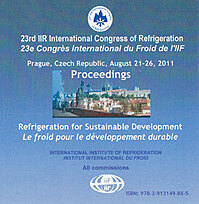
Document IIF
Caractéristiques d'écoulement et de transfert de chaleur d'un coulis de glace autour d'un corps chauffé.
Flow and heat transfer characteristics of ice slurry around heated body.
Numéro : pap. ID: 320
Auteurs : KAWANAMI T., TOGASHI K., FUMOTO K., et al.
Résumé
This paper presents the flow and heat transfer characteristics around horizontal cylinders immersed in an ice slurry flow. A trehalose aqueous solution is utilized as the liquid phase for the testing ice slurry. Trehalose, which is a kind of disaccharide composed of two glucose units, is a naturally derived material and inhibits the growth of ice crystals. The basic components of the apparatus are a cooling brine circulating loop, a tank to produce and store ice slurry, an ice slurry flow circulating loop containing the test section, and the associated instrumentation. Experimental investigation is carried out by considering specific parameters and features such as the ice slurry flow velocity, heat flux of the heated surface, and the formation of a cylinder array. An evaluation of the local heat transfer coefficient and the observation of the flow behavior indicate that the distribution of the local heat transfer coefficient is strongly affected by both the flow behavior around the heated cylinder and the latent heat of the ice particles.
Documents disponibles
Format PDF
Pages : 8 p.
Disponible
Prix public
20 €
Prix membre*
Gratuit
* meilleur tarif applicable selon le type d'adhésion (voir le détail des avantages des adhésions individuelles et collectives)
Détails
- Titre original : Flow and heat transfer characteristics of ice slurry around heated body.
- Identifiant de la fiche : 30002461
- Langues : Anglais
- Source : Proceedings of the 23rd IIR International Congress of Refrigeration: Prague, Czech Republic, August 21-26, 2011. Overarching theme: Refrigeration for Sustainable Development.
- Date d'édition : 21/08/2011
Liens
Voir d'autres communications du même compte rendu (569)
Voir le compte rendu de la conférence
Indexation
-
Influence of a heat flux to ice adhesion force.
- Auteurs : SCHAAF J., KOFFLER M., KAUFFELD M.
- Date : 16/08/2015
- Langues : Anglais
- Source : Proceedings of the 24th IIR International Congress of Refrigeration: Yokohama, Japan, August 16-22, 2015.
- Formats : PDF
Voir la fiche
-
Heat transfer and flow behavior of ice slurry a...
- Auteurs : TOGASHI K., KAWANAMI T., FUMOTO K., et al.
- Date : 01/07/2012
- Langues : Anglais
- Source : 10th International Conference on Phase-Change Materials and Slurries for Refrigeration and Air Conditioning. Proceedings: Kobe, Japan, July 29-August 1, 2012.
- Formats : PDF
Voir la fiche
-
Numerical simulation of ice slurry flow in impr...
- Auteurs : HEFNY S., THOMAS C., HESSE U.
- Date : 05/2021
- Langues : Anglais
- Source : 2021 Purdue Conferences. 18th International Refrigeration and Air-Conditioning Conference at Purdue.
- Formats : PDF
Voir la fiche
-
Ice slurry production in a tubular heat exchanger.
- Auteurs : LE BAIL A., HAVET M.
- Date : 16/08/2015
- Langues : Anglais
- Source : Proceedings of the 24th IIR International Congress of Refrigeration: Yokohama, Japan, August 16-22, 2015.
- Formats : PDF
Voir la fiche
-
Applicability of numerical code for simulation ...
- Auteurs : HEFNY S., TANNERT T., HESSE U.
- Date : 24/08/2019
- Langues : Anglais
- Source : Proceedings of the 25th IIR International Congress of Refrigeration: Montréal , Canada, August 24-30, 2019.
- Formats : PDF
Voir la fiche
